Papers by Victor Manuel Suñe Socias

Methodology and Computing in Applied Probability, 2016
By combining in a novel way the randomization method with the stationary detection technique, we ... more By combining in a novel way the randomization method with the stationary detection technique, we develop two new algorithms for the computation of the expected reward rates of finite, irreducible Markov reward models, with control of the relative error. The first algorithm computes the expected transient reward rate and the second one computes the expected averaged reward rate. The algorithms are numerically stable. Further, it is argued that, from the point of view of run-time computational cost, for medium-sized and large Markov reward models, we can expect the algorithms to be better than the only variant of the randomization method that allows to control the relative error and better than the approach that consists in employing iteratively the currently existing algorithms that use the randomization method with stationarity detection but allow to control the absolute error. The performance of the new algorithms is illustrated by means of examples, showing that the algorithms can be not only faster but also more efficient than the alternatives in terms of run-time computational cost in relation to accuracy.
Universitat Politècnica de Catalunya, Jun 23, 2017
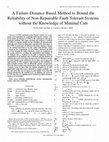
CTMC (continuous-time Markov chains) are a commonly used formalism for modeling fault-tolerant sy... more CTMC (continuous-time Markov chains) are a commonly used formalism for modeling fault-tolerant systems. One of the major drawbacks of CTMC is the well-known state-space explosion problem. This paper develops and analyzes a method (SC-BM) to compute bounds for the reliability of nonrepairable fault-tolerant systems in which only a portion of the state space of the CTMC is generated. SC-BM uses the failure distance concept as the method described in [1] but, unlike that method, which is based on the computation of exact failure distances, SC-BM uses lower bounds for failure distances, which are computed on the system fault-tree, avoiding the computation and holding of all minimal cuts as required in [1]. This is important because computation of all minimal cuts is NP-hard and the number of minimal cuts can be very large. In some cases SC-BM gives exactly the same bounds as the method in [1]; in other cases it gives less tighter bounds. SC-BM computes tight bounds for the reliability o...
Recull de problemes d'examen d'amplificadors operacional
Proceedings Fifth International Symposium on Modeling, Analysis, and Simulation of Computer and Telecommunication Systems
A Method for the Computation of Reliability Bounds for Non-repairable Faulttolerant Systems* Vict... more A Method for the Computation of Reliability Bounds for Non-repairable Faulttolerant Systems* Victor Sufi6 a n d J u a n A. Carrasco D e p a r t a m e n t d'Enginyeria Electrbnica, UPC Diagonal 647, plta. 9, 08028 Barcelona, S p a i n { sunye, carr
MASCOTS '99. Proceedings of the Seventh International Symposium on Modeling, Analysis and Simulation of Computer and Telecommunication Systems
We propose an algorithm to compute bounds for the steadystate unavailability using continuous-tim... more We propose an algorithm to compute bounds for the steadystate unavailability using continuous-time Markov chains, which is based on the failure distance concept. The algorithm generates incrementally a subset of the state space until the tightness of the bounds is the specified one. In contrast with a previous algorithm also based on the failure distance concept, the proposed algorithm uses lower bounds for failure distances which are computed on the fault tree of the system, and does not require the knowledge of the minimal cuts. This is advantageous when the number of minimal cuts is large or their computation is time-consuming.
Problemes d'examen d'aplicacions dels comparadors de tensi
Problemes d'examen de circuits de potència amb solucionsResolve
Examen final sense soluci
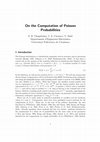
The Poisson distribution is a distribution commonly used in statistics. It also plays a central r... more The Poisson distribution is a distribution commonly used in statistics. It also plays a central role in the analysis of the transient behaviour of continuous-time Markov chains. Several methods have been devised for evaluating using floating-point arithmetic the probability mass function (PMF) of the Poisson distribution. Restricting our attention to published methods intended for the computation of a single probability or a few of them, we show that neither of them is completely satisfactory in terms of accuracy. With that motivation, we develop a new method for the evaluation of the PDF of the Poisson distribution. The method is intended for the computation of a single probability or a few of them. Numerical experimentation illustrates that the method can be more accurate and slightly faster than the previous methods. Besides, the method comes with guaranteed approximation relative error.
Applied Mathematics and Computation, 2017
Obtaining the transient probability distribution vector of a continuous-time Markov chain (CTMC) ... more Obtaining the transient probability distribution vector of a continuous-time Markov chain (CTMC) using an implicit ordinary differential equation (ODE) solver tends to be advantageous in terms of run-time computational cost when the product of the maximum output rate of the CTMC and the largest time of interest is large. In this paper, we show that when applied to the transient analysis of CTMCs, many implicit ODE solvers are such that the linear systems involved in their steps can be solved by using iterative methods with strict control of the 1-norm of the error. This allows the development of implementations of those ODE solvers for the transient analysis of CTMCs that can be more efficient and more accurate than more standard implementations.
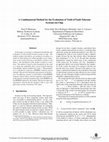
2003 International Conference on Dependable Systems and Networks, 2003. Proceedings.
In this paper we develop a combinatorial method for the evaluation of yield of fault-tolerant sys... more In this paper we develop a combinatorial method for the evaluation of yield of fault-tolerant systems-on-chip. The method assumes that defects are produced according to a model in which defects are lethal and affect given components of the system following a distribution common to all defects. The distribution of the number of defects is arbitrary. The method is based on the formulation of the yield as 1 minus the probability that a given boolean function with multiple-valued variables has value 1. That probability is computed by analyzing a ROMDD (reduced ordered multiple-value decision diagram) representation of the function. For efficiency reasons, we first build a coded ROBDD (reduced ordered binary decision diagram) representation of the function and then transform that coded ROBDD into the ROMDD required by the method. We present numerical experiments showing that the method is able to cope with quite large systems in moderate CPU times.
This paper targets the reliability analysis of a fault-tolerant MIN network (the ASEN-Max network... more This paper targets the reliability analysis of a fault-tolerant MIN network (the ASEN-Max network) in a non-repairable context. We show that, under certain conditions concerning how the operation of the network is controlled, the network is non-coherent, preventing the use of combinatorial techniques. Finally, we examine the limitations of continuous-time Markov chain (CTMC) techniques.

2. Fast generation of very large rewarded CTMC models. 3. Well tested (almost 100% coverage of re... more 2. Fast generation of very large rewarded CTMC models. 3. Well tested (almost 100% coverage of reachable code). 4. Computation using numerical methods and estimation using simulation of seven reward measures in almost their full generality. 5. Incorporation of numerical methods targeted at the computation of some reward measures or bounds for them for classes of finite CTMC models including both exact and bounding failure/repair models of fault-tolerant systems with exponential failure and repair time distributions and repair in every state with failed components and, perhaps, that the structure function of the modeled system be increasing, with component failure rates much smaller than component repair rates. This document describes and explains how to use METFAC-2.1. Section 1 is a short tutorial introduction to the usage of the tool. Section 2 gives a detailed description of the model specification language based on production rules supported by the tool. Section 3
Microelectronics Reliability, 2004
IEE Proceedings - Communications, 2001
Tous droits de propriété intellectuelle réservés. Reproduction, rcpréseniation ct dillilsion inte... more Tous droits de propriété intellectuelle réservés. Reproduction, rcpréseniation ct dillilsion interdites. Loi du 01/07/92.
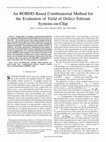
IEEE Transactions on Very Large Scale Integration (VLSI) Systems, 2009
In this paper, we develop a combinatorial method for the evaluation of the functional yield of de... more In this paper, we develop a combinatorial method for the evaluation of the functional yield of defect-tolerant systems-onchip (SoC). The method assumes that random manufacturing defects are produced according to a model in which defects cause the failure of given components of the system following a distribution common to all defects. The distribution of the number of defects is arbitrary. The yield is obtained by conditioning on the number of defects that result in the failure of some component and performing recursive computations over a reduced ordered binary decision diagram (ROBDD) representation of the fault-tree function of the system. The method has excellent error control. Numerical experiments seem to indicate that the method is efficient and, with some exceptions, allows the analysis with affordable computational resources of systems with very large numbers of components. Index Terms-Combinatorial method, defect-tolerant systems-on-chip (SoC), manufacturing defects, reduced ordered binary decision diagram (ROBDD), yield.
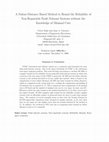
IEEE Transactions on Reliability, 2001
& Conclusions CTMC (continuous-time Markov chains) are a commonly used formalism for modeling fau... more & Conclusions CTMC (continuous-time Markov chains) are a commonly used formalism for modeling fault-tolerant systems. One of the major drawbacks of CTMC is the well-known state-space explosion problem. This work develops and analyzes a method (SC-BM) to compute bounds for the reliability of non-repairable fault-tolerant systems in which only a portion of the state space of the CTMC is generated. SC-BM uses the failure distance concept as the method described in [1] but, unlike that method, which is based on the computation of exact failure distances, SC-BM uses lower bounds for failure distances, which are computed on the system fault tree, avoiding the computation and holding of all minimal cuts as required in [1]. This is important since computation of all minimal cuts is NP-hard and the number of minimal cuts can be very large. In some cases SC-BM gives exactly the same bounds as the method described in [1]; in other cases it gives less tighter bounds. SC-BM computes tight bounds for the reliability of quite complex systems with an affordable number of generated states for short to quite large mission times. The analysis of several examples seems to show that the bounds obtained by SC-BM appreciably outperform those obtained by simpler methods, eg [2], and, when they are not equal, are only slightly worse than the bounds obtained by the method in [1]. In addition, the overhead in CPU time due to computing lower bounds for failure distances seems to be reasonable.
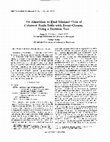
IEEE Transactions on Reliability, 1999
& Conclusions-A new algorithm (CS-MC) for computing the minimal cuts of scoherent fault trees is ... more & Conclusions-A new algorithm (CS-MC) for computing the minimal cuts of scoherent fault trees is presented. Input events of the fault tree are assumed classified into classes, where events of the same class are indistinguishable. This allows capturing some symmetries which some systems exhibit. CS-MC uses a decision tree. The search implemented by the decision tree is guided by heuristics which try to make CS-MC as efficient as possible. In addition, an irrelevance test on the inputs of the fault tree is used to prune the search. The performance of CS-MC is illustrated and compared with the basic topdown and bottom-up algorithms using a set of fault trees, some of which are very difficult. The CS-MC performs very well even in the difficult examples, and the memory requirements of CS-MC are small. 'The singular & plural of an acronym are always spelled the same. 2The term 'minimal cut' is used instead of the more common 'minimal cutset' because the minimal cuts in this paper are bags.
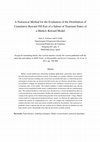
IEEE Transactions on Dependable and Secure Computing, 2011
Markov reward models have interesting modeling applications, particularly those addressing fault-... more Markov reward models have interesting modeling applications, particularly those addressing fault-tolerant hardware/software systems. In this paper, we consider a Markov reward model with a reward structure including only reward rates associated with states, in which both positive and negative reward rates are present and null reward rates are allowed, and develop a numerical method to compute the distribution function of the cumulative reward till exit of a subset of transient states of the model. The method combines a model transformation step with the solution of the transformed model using a randomization construction with two randomization rates. The method introduces a truncation error, but that error is strictly bounded from above by a user-specified error control parameter. Further, the method is numerically stable and takes advantage of the sparsity of the infinitesimal generator of the transformed model. Using a Markov reward model of a fault-tolerant hardware/software system, we illustrate the application of the method and analyze its computational cost. Also, we compare the computational cost of the method with that of the (only) previously available method for the problem. Our numerical experiments seem to indicate that the new method can be efficient and that for medium-size and large models can be substantially faster than the previously available method.

Uploads
Papers by Victor Manuel Suñe Socias